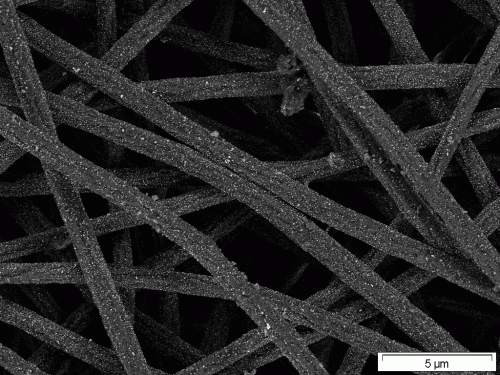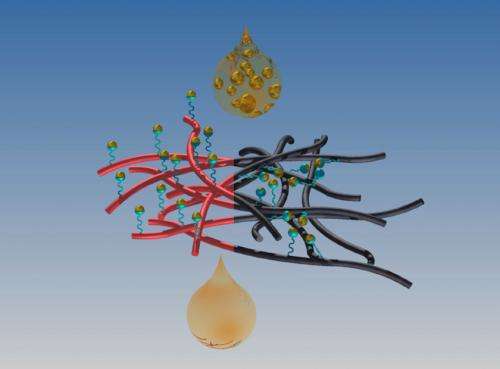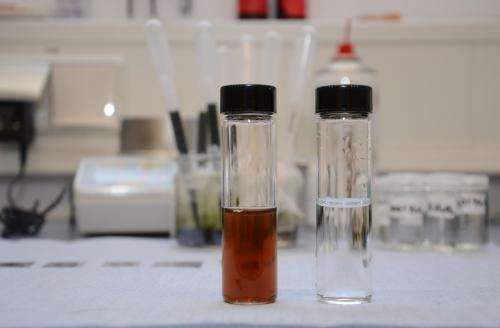Sieve holds nanoparticles and acts as solar absorber

(Phys.org)—A membrane consisting of polymer fibres and proteins makes a novel filter for tiny, nano-scaled particles in aqueous solutions. The result of such a research, which was done by Professor Mady Elbahri and his team from the Institute of Material Science at Kiel University (KU) and the Institute of Polymer Research at Helmholtz-Zentrum Geesthacht (HZG), has recently been published as the cover article in the current issue of Advanced Functional Materials.
A Nanofluid, which means a colloidal suspension of e.g. metal nanoparticles in water, passes easily through commonly used macroporous polymeric mem-branes. The particles are too small to be held using hole diameters between three and four micrometers. In addition, the particles would block smaller sieve openings rapidly. Hence, pressure would be necessary to filter out the fluid.

In order to solve these problems, Elbahri and his team biofunctionalized their membrane and added a commercially available protein to the fibres. "We found out that the protein undergoes a conformational change under water, and its ability to capture all the metal nanoparticles during the filtration process is acti-vated", explains Elbahri. "This is a breakthrough", adds Co-author Dr. Shahin Homaeigohar. "The same principle will hopefully enable us, to filter bio-molecules and organisms out of waste water."
From Filtration to solar thermal energy
When the nano sieve captures metal particles such as gold, another application is at hand, because, no other method has succeeded in dispersing the particles that well. "This result was unexpected", says Elbahri. "Under dry conditions, the membrane shows the color of the metal, in this case the red of the gold nanoparticles". When the membrane gets wet, it becomes black. "Then, it acts as an omnidirectional perfect black absorber, which can be used as a solar absorber." Elbahri adds: "Indeed we bridge the gaps between several disci-plines, chemistry, physics, bioscience and materials science that is, and the Nanochemistry and Nanoengineering group has now initiated the first step toward intradisciplinarity of Nanoscience."

Application as a virus and bio-filter
The nano sieve will allow filtering very small particles or biomolecules and or-ganisms such as viruses out of water. The scientists involved have already pat-ented their innovation, a bio-nano-composite, in Europe. Another patent for the USA is on its way. Besides its application in water filtration, the nano sieve shows great potentials as solar absorber and as a catalyser. "All in all, the result is a breakthrough towards the design of an operative filtration process, as a new route for the fabrication of functional materials, and offers commercially attrac-tive efficiencies at a low cost", says Elbahri.
More information: Elbahri, M. et al., Smart Metal-Polymer Bionanocomposites as Omnidirectional Plasmonic Black Absorber by Nanofluid Filtration, Advanced Functional Materials, 22, 4771, 2012. DOI: 10.1002/adfm.201200768
Journal information: Advanced Functional Materials
Provided by Kiel University



















